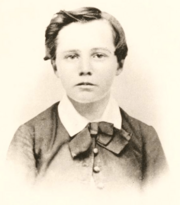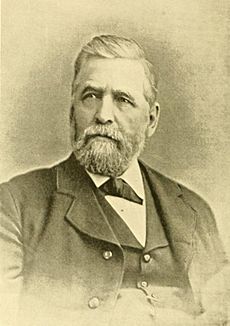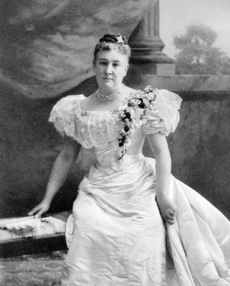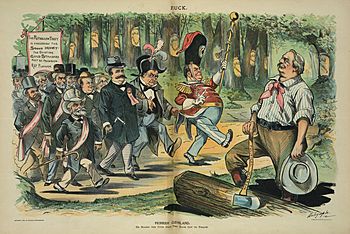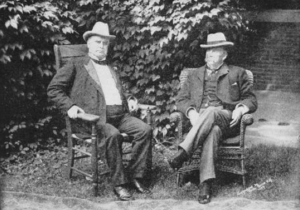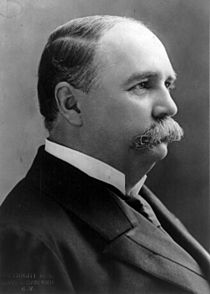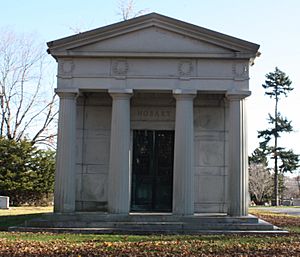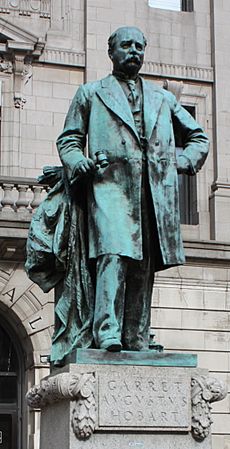Garret Hobart facts for kids
Quick facts for kids
Garret Hobart
|
|
|---|---|

Hobart, c. 1897
|
|
| 24th Vice President of the United States | |
| In office March 4, 1897 – November 21, 1899 |
|
| President | William McKinley |
| Preceded by | Adlai Stevenson |
| Succeeded by | Theodore Roosevelt |
| President of the New Jersey Senate | |
| In office January 11, 1881 – January 9, 1883 |
|
| Preceded by | William Joyce Sewell |
| Succeeded by | John J. Gardner |
| Speaker of the New Jersey General Assembly | |
| In office January 13, 1874 – January 12, 1875 |
|
| Preceded by | Isaac L. Fisher |
| Succeeded by | George O. Vanderbilt |
| Member of the New Jersey Senate from Passaic County |
|
| In office January 9, 1877 – January 9, 1883 |
|
| Preceded by | John Hopper |
| Succeeded by | John W. Griggs |
| Member of the New Jersey General Assembly from Passaic's 3rd district |
|
| In office January 14, 1873 – January 12, 1875 |
|
| Preceded by | Robert M. Torbet |
| Succeeded by | Robert M. Torbet |
| Personal details | |
| Born |
Garret Augustus Hobart
June 3, 1844 Long Branch, New Jersey, U.S. |
| Died | November 21, 1899 (aged 55) Paterson, New Jersey, U.S. |
| Resting place | Cedar Lawn Cemetery, Paterson, New Jersey, U.S. |
| Political party | Republican |
| Spouse |
Jennie Tuttle
(m. 1869) |
| Children | 4 |
| Relatives | George S. Hobart (nephew) |
| Education | Rutgers College (BA) |
| Profession | |
| Signature | |
Garret Augustus Hobart (born June 3, 1844 – died November 21, 1899) was the 24th Vice President of the United States. He served from 1897 until his death in 1899. Before becoming Vice President, Hobart was a successful businessman and politician in New Jersey.
Hobart was born in Long Branch, New Jersey. He grew up in nearby Marlboro Township, New Jersey. After attending Rutgers College, he studied law with a well-known lawyer named Socrates Tuttle in Paterson, New Jersey. Hobart married Tuttle's daughter, Jennie. Even though he rarely went to court, Hobart became rich as a lawyer for companies. He also served in local government.
Hobart was a Republican. He was elected to the New Jersey General Assembly, where he became Speaker in 1874. Later, he served in the New Jersey Senate, becoming its president in 1881. He was a loyal party member. In 1896, New Jersey Republicans wanted him to be the Vice President. His political ideas were similar to William McKinley, who was expected to be the Republican presidential candidate. Since New Jersey was an important state, McKinley and his advisor, Mark Hanna, chose Hobart. Hobart campaigned from his home, just like McKinley. McKinley and Hobart won the election.
As Vice President, Hobart was popular in Washington, D.C. He was a close advisor to President McKinley. Hobart was known for his good manners and humor. These qualities helped McKinley, especially when Secretary of War Russell Alger didn't understand that McKinley wanted him to resign. Hobart invited Alger to his summer home and gently told him the news. Alger resigned when he returned to Washington. Hobart died on November 21, 1899, from heart disease at age 55. Theodore Roosevelt, who was then the Governor of New York, took his place on the Republican ticket for the 1900 election.
Contents
Early Life and Education
Garret Augustus Hobart was born on June 3, 1844. His parents were Addison Willard Hobart and Sophia Vanderveer. Addison Hobart was a teacher who came to New Jersey from New England. Sophia's family came from Dutch settlers in New York. Garret was the second of three boys.
Hobart first went to his father's school in Long Branch. In the early 1850s, his family moved to Marlboro. He attended the village school there. People said he was an excellent student and a leader in sports. His father sent him to a good school in Freehold. After a disagreement, he went to Middletown Point Academy in Matawan, New Jersey.
Hobart graduated at age 15. His parents thought he was too young for college. So, he stayed home for a year to study and work part-time. In 1860, Hobart started at Rutgers College. He graduated in 1863, ranking third in his class. Later in life, Hobart gave a lot of money to Rutgers. He received an honorary degree after becoming Vice President.
Becoming a Lawyer and Politician
Starting a Law Career
After college, Hobart taught briefly to pay off loans. He did not serve in the Union Army during the Civil War. A friend of his father, lawyer Socrates Tuttle, offered to teach Hobart law in his office. Tuttle was a well-known lawyer in Passaic County. He had also served in the state government. Hobart worked as a bank clerk in Paterson to support himself. He later became a director of that same bank.
Hobart became a lawyer in 1866. He married Tuttle's daughter, Jennie Tuttle Hobart, on July 21, 1869. The Hobarts had four children, but only one son, Garret Jr., lived to adulthood. Hobart's marriage to Jennie, whose family was Republican, led him to become a Republican too.
Socrates Tuttle was very important in Paterson. This helped Hobart a lot. In 1866, Hobart became a clerk for the grand jury in Passaic County. When Tuttle became mayor of Paterson in 1871, he made Hobart the city's lawyer. A year later, Hobart became the lawyer for the county's Board of Chosen Freeholders.
Early Steps in Politics
In 1872, Hobart ran as a Republican for the New Jersey General Assembly. He won easily. The General Assembly was elected every year. He won re-election the next year.
In 1874, at just 30 years old, he was voted Speaker of the Assembly. In 1876, he was chosen to run for the New Jersey Senate for Passaic County. He won a three-year term and was re-elected in 1879. In 1881 and 1882, he was President of the state Senate. This made him the first person to lead both houses of the New Jersey legislature.
In 1883, he was nominated by Republicans for the United States Senate. At that time, state legislatures chose senators. Since Democrats were the majority, this nomination was a way to honor Hobart for his service. He said he didn't worry about things that didn't happen. This was his only election loss.
Hobart said that politics was his "recreation." He spent most of his time on his law practice, which made him very rich. He rarely went to court. His main work was advising companies on how to follow the law. He also made money by helping bankrupt railroads get back on track. He often invested in these companies.
Hobart was successful because of his friendly personality. He worked well with others and was known for being polite and charming. He chose not to run for Congress earlier because he liked his comfortable life in Paterson. Instead, he stayed involved in party politics. He was seen as the most important Republican in Northern New Jersey. From 1876, he was a delegate to every Republican National Convention. He led the New Jersey Republican Committee from 1880 to 1891. He also became vice chairman of the national Republican Committee.
The 1896 Election
Becoming a Candidate
Jennie Hobart, his wife, thought her husband might become a Vice President candidate in March 1895. She had lunch with him in New York. Mark Hanna, a powerful businessman, asked what Garret Hobart thought of William McKinley becoming president. Jennie believed this was the start of her husband's journey to national office.
In November 1895, John W. Griggs became the first Republican governor of New Jersey since the 1860s. Hobart had managed his campaign. This led to newspapers guessing that Hobart might run for Vice President. New Jersey Republicans wanted Hobart on the national ticket. They hoped it would help Republicans win more votes in their state. Hobart was a good choice because he was from a "swing state" (a state that could vote for either party). He was also wealthy and could help pay for his own campaign.
Historians say that Hobart helped McKinley get support from New Jersey at the 1896 Republican National Convention. McKinley and Hanna wanted someone from the East Coast to balance the ticket. This would help them get more support in the Mid-Atlantic states. Usually, they would pick someone from New York, the largest state. But many New York delegates supported their own candidate, so giving them the Vice President spot didn't seem fair.
McKinley was chosen as the presidential candidate on the first vote. Hobart was then chosen for Vice President on the first vote too. This was partly because of his friends and partly because Hanna wanted a candidate who would appeal to businesses. Hobart was a corporate lawyer, so he fit perfectly. Hobart wrote to his wife that he was "dismayed" by the thought of being nominated. He worried about the "work, worry, and loss of home and bliss." But he was welcomed home by 15,000 people in Paterson.
In June 1896, Republicans felt good about their candidates and their plans. They thought the election would be about tariffs (taxes on imported goods) and would be an easy win. On June 30, Hobart traveled to Canton, Ohio, McKinley's hometown. They met and spoke to supporters. They became friends quickly.
The Campaign
The country was facing tough economic times in 1896. One idea to fix the economy was "Free Silver". This meant the government would make silver coins worth less than their face value. This would increase the money supply but could cause problems with other countries that used the gold standard. Supporters thought more money would help the economy. President Grover Cleveland strongly supported the gold standard. This divided the Democratic Party. Most Republicans also supported the gold standard.
In July, the Democrats chose William Jennings Bryan as their presidential candidate. He was a strong supporter of "Free Silver." His famous Cross of Gold speech helped him win the nomination. This led to a lot of public support for the Democrats.
Hobart strongly supported the gold standard. He insisted it remain a key part of the Republican campaign. He said that a dollar should be worth 100 cents everywhere. He believed that making coins from less valuable silver would cause "incalculable loss" and "National dishonor." McKinley was not as strong on the gold standard as Hobart. But Hobart insisted his views be printed without changes. He believed the money issue, not tariffs, would decide the election.
Hobart helped run McKinley's campaign office in New York. He often traveled from Paterson for meetings. Like McKinley, he gave speeches from his home, known as a "front porch campaign". He also spoke at rallies. In October, he toured New Jersey to campaign. On November 3, 1896, McKinley and Hobart won the election. They won New Jersey and the entire Northeast. The next week, Hobart attended Rutgers' 130th-anniversary celebration as a special guest.
Vice Presidency (1897–1899)
Hobart spent the time between the election and his inauguration preparing for his new role. He read about the Vice Presidency and took care of some business matters. He did not resign from all company boards, only those that would deal with the federal government. On March 2, 1897, Hobart and his family traveled to Washington, D.C. He was sworn in as Vice President on March 4.
A Presidential Advisor
The Hobarts moved into a house at 21 Madison Place in Washington, D.C. It was across from the White House. This house became known as the "Cream White House." Senator Mark Hanna often visited for breakfast.
President McKinley and Vice President Hobart were already friends. After the inauguration, they became even closer. The First Lady, Ida Saxton McKinley, had health problems. She couldn't handle all the official events. So, Jennie Hobart often filled in for her. She also visited Ida every day. The Hobarts and McKinleys visited each other's homes informally. Jennie Hobart later wrote that no other Vice President and President had such a close friendship. The Hobarts often hosted parties. This was helpful for McKinley, who could meet with members of Congress informally.
Before Hobart, the Vice President's job was mostly just to lead the Senate. But Hobart became a close advisor to McKinley and his Cabinet. He didn't attend Cabinet meetings, but he was still very influential. A reporter wrote that Hobart was the first Vice President to be seen as "somebody" and a true part of the administration.
In 1897 and 1898, many Americans wanted the U.S. to get involved in Cuba. Cuba was a Spanish colony fighting for independence. Calls for war grew louder after the American battleship Maine sank in Havana harbor in February 1898. McKinley wanted to solve things peacefully. But in April 1898, Hobart told the President that the Senate would act against Spain no matter what. McKinley agreed. Congress declared war on April 25, starting the Spanish–American War. Hobart sent McKinley a pen to sign the declaration.
"Assistant President"
Hobart was more active as the Senate president than those before him. Usually, the Vice President would let the Senate vote on disagreements. But Hobart, with his experience in the New Jersey legislature, took a stronger role. He made decisions on disputes and tried to speed up new laws. He was so good at guiding the administration's plans through the Senate that he became known as the "assistant President."
Hobart was always present in the Senate. He only cast a tie-breaking vote once. He used it to stop a change that would have promised self-government to the Philippines. The Philippines was one of the places the U.S. took from Spain after the war. Hobart was also important in getting the Treaty of Paris approved. This treaty ended the war.
Hobart kept his position as an arbiter for the Joint Traffic Association (JTA). This was a group of railroads that tried to set fair prices. If two railroads disagreed, Hobart and two others would settle it. He heard appeals even as Vice President. In 1897, the Supreme Court hinted that the JTA might be breaking the Sherman Antitrust Act. Hobart resigned from the JTA in November 1897. Hobart also invested a lot in the Ramapo Water Company. In 1899, there was a controversy about a plan for this company to sell water to New York City at high prices. The plan was never approved. An investigation found no wrongdoing, but Hobart's role was talked about in the news.
Illness and Death
By late 1898, Hobart became very sick with a heart problem. He kept it a secret at first. He continued his Senate duties but almost collapsed after giving a speech. He went on vacation with the President but got the flu and returned to Washington. By April 1899, the public knew about his illness. But Hanna told newspapers that Hobart would still be on the ticket in 1900.
Hobart rented a home in his birthplace of Long Branch. Doctors told him to rest completely. He amused himself by feeding two pet fish, one named McKinley and one named Bryan.
Even though Hobart was sick, McKinley asked him to tell Secretary of War Russell Alger that McKinley wanted him to resign. Alger had ignored hints from the President. Hobart invited Alger to Long Branch and told him the news. Alger then resigned. Hobart's health got worse quickly after Alger's visit. He was soon bedridden.
After a vacation with the McKinleys, Hobart returned to Paterson in September. On November 1, 1899, the government announced that Hobart would not return to public life. His condition worsened quickly. He died on November 21, 1899, at age 55. President McKinley told the family, "No one outside of this home feels this loss more deeply than I do."
New Jersey Governor Foster Voorhees ordered state buildings to be decorated for mourning for 30 days. Flags were flown at half-staff until Hobart's funeral. Hobart's home was opened to the public for four hours. About 12,000 people came to see his open casket. Hobart was buried at Cedar Lawn Cemetery in Paterson after a large public funeral. President McKinley and many high government officials attended. About 50,000 people came to Paterson to honor Hobart.
The mausoleum over his grave was built in 1901. It cost about $80,000. It has large marble columns and a heavy metal door. Inside, there are two stone coffins for Garret Hobart and his wife.
Hobart's Legacy
Hobart greatly increased the power of the Vice Presidency. He became a trusted advisor to the President. He also took a strong leadership role as the president of the Senate. He was perhaps the most influential Vice President since Martin Van Buren.
Today, Garret Hobart is not widely remembered. He is best known for his death, which allowed Theodore Roosevelt to become Vice President in 1900. Roosevelt then became President after McKinley was assassinated in 1901.
A statue of Hobart was put up in 1903 outside Paterson's city hall. The towns of Hobart, Oklahoma and Hobart, Washington are named after him.
Electoral history
</tr"></tr"></tr"></tr"></tr"></tr">
| Election | Political result | Candidate | Party | Votes | % | ±% | ||
|---|---|---|---|---|---|---|---|---|
| New Jersey General Assembly – Passaic County, Third District – November 5, 1872. | Republican Party (United States)Republican hold | Garret Hobart | Republican Party (United States)Republican | 1,787 | 65.03 | |||
| William Oakley | Democratic Party (United States)Democrat | 961 | 34.97 | |||||
| New Jersey General Assembly – Passaic County, Third District – November 4, 1873. | Republican Party (United States)Republican hold | Garret Hobart* | Republican Party (United States)Republican | 1,490 | 59.29 | |||
| Gerrit Planten | Democratic Party (United States)Democrat | 1,023 | 40.71 | |||||
| New Jersey Senate – Passaic County – November 7, 1876 | Republican Party (United States)Republican gain from Democratic | Garret Hobart | Republican Party (United States)Republican | 5,912 | 54.16 | |||
| Charles Inglis | Democratic Party (United States)Democrat | 5,022 | 45.84 | |||||
| New Jersey Senate – Passaic County – November 4, 1879 | Republican Party (United States)Republican hold | Garret Hobart* | Republican Party (United States)Republican | 5,546 | 59.54 | |||
| Garret A. Hopper | Democratic Party (United States)Democrat | 3,647 | 39.15 | |||||
| John Warr | Greenback PartyGreenback | 122 | 1.31 | |||||
| 1883 United States Senate election in New Jersey – by the New Jersey Legislature in joint session – January 24, 1883 For the six-year term beginning March 4, 1883. McPherson was elected on the first ballot; 41 votes needed for election. |
Democratic Party (United States)Democrat hold | John R. McPherson* | Democratic Party (United States)Democrat | 43 | 53.09 | |||
| Garret Hobart | Republican Party (United States)Republican | 36 | 44.44 | |||||
| George C. Ludlow | Democratic Party (United States)Democrat | 2 | 2.47 | |||||
| 1896 United States presidential election – Electoral College balloting for vice president. – Popular vote November 3, 1896 in most states. The Democrats and People's Party (or Populists) both nominated William Jennings Bryan for president but the two parties chose different vice presidential candidates. Hobart's presidential running mate was William McKinley, who was also elected with 271 electoral votes. Candidates required 224 electoral votes for a majority. For the popular vote, see 1896 United States presidential election. |
Republican Party (United States)Republican gain from Democratic | Garret Hobart | Republican Party (United States)Republican | 271 | 60.63 | |||
| Arthur Sewall | Democratic Party (United States)Democrat | 149 | 33.33 | |||||
| Thomas E. Watson | Populist Party | 27 | 6.04 | |||||
* Incumbent
Images for kids
See also
 In Spanish: Garret Hobart para niños
In Spanish: Garret Hobart para niños


